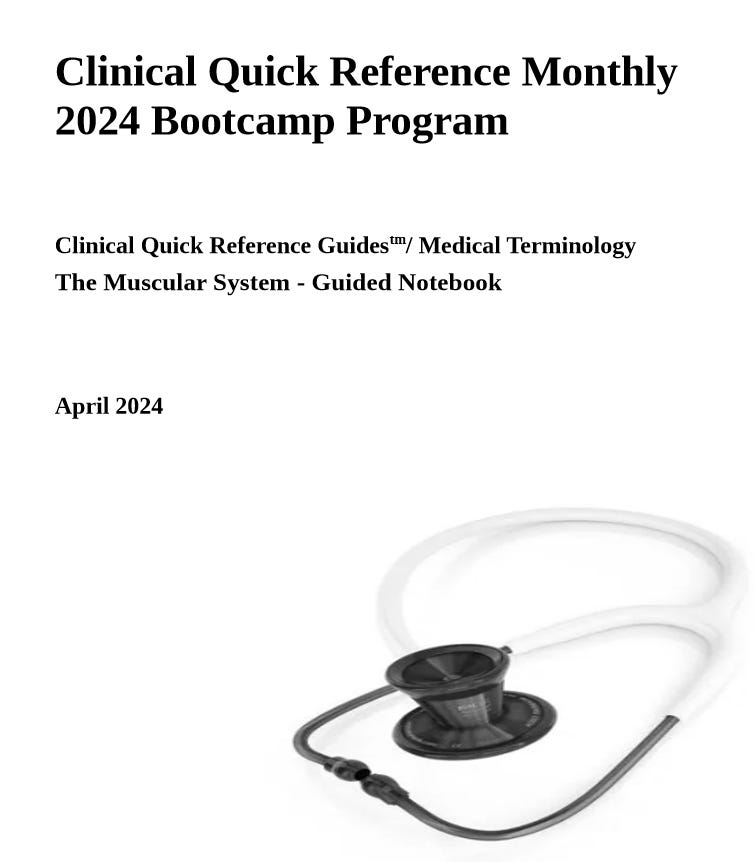CQRG 2024 Medical Terminology Bootcamp
SESSION 7 / THE MUSCULAR SYSTEM OVERVIEW
Welcome!
If you are new to our medical terminology program we invite you to browse our previous lessons and program activities. Simply click on the PROGRAMS tab above to view individual lessons and materials. Additional activities and reviews are posted on a weekly basis in the NOTES section. Each lesson in the program is a standalone experience, so there is never a worry if you need to take a break. Subscribe to receive the lessons emailed to you, or follow along in the Notes section.
The Muscular System
Our muscles are one of the body’s four main tissue types.
There are three kinds of muscle tissue: cardiac, skeletal, and smooth. Cardiac muscle cells are found in the wall of the heart. Smooth muscle fibers are found in walls of the hollow visceral organs. Skeletal muscles help move our skeleton.
In all, there are over 600 muscles in the human body.
Anatomy
Muscle is composed of specialized cells known as fibers.
There are three different forms of muscle tissue in the body:
cardiac,
smooth, and
skeletal muscle.
A characteristic shared by the muscle tissues is excitability. This refers to the ability of their plasma membranes to transition from polarized to depolarized states and to transmit an electrical wave known as an action potential throughout the membrane's whole length.
Key term: excitability
ability to respond to a stimulus;
may be delivered from a motor neuron (or a hormone)
Muscles are surrounded by fibrous connective tissue, or fascia. Fascia is a layer of connective tissue that helps support tissues and organs.
A Closer Look At The Muscle Types
Cardiac Muscle
There is only cardiac muscle tissue in the heart. Well-coordinated heart muscle contractions push blood into and through the arteries. Heart muscle is striated and arranged into sarcomeres, with the same banding arrangement as skeletal muscle.
The cells that make up cardiac muscle fibers are highly branched as well, and intercalated discs join them at the ends. To enable the heart to function as a pump, an intercalated disc permits the cardiac muscle cells to contract in a wave-like way.
Smooth Muscle
The walls of hollow organs such as the bladder, uterus, stomach, and intestines contain smooth muscle. This muscle type gets its name from the lack of striations in its cells.
Smooth muscle is also found in the walls of arteries and veins of the circulatory system and the tracts that house the respiratory, urinary, and reproductive systems. In the skin, smooth muscle allows hair to stand straight in reaction to cold or fear.
Skeletal Muscles
Our skeletal muscles help facilitate movement and regulate the flow of various substances. they are found throughout the body at the entrances of internal systems. These muscles enable voluntary activities; these include defecation, swallowing, and urinating.
Skeletal muscles support the weight of internal organs and serve to shield against external assault. Our skeletal muscles protect our internal organs, especially our abdominal and pelvic organs.
By producing heat, skeletal muscles aid in the preservation of homeostasis. This heat is most noticeable when one is exercising, when prolonged muscle movement raises body temperature, or when one is extremely cold and shivering induces random spasms of the skeletal muscles, which raise body temperature.
Physiology
The primary role of the muscular system is to aid in movement. Muscles function in antagonistic pairs, where one muscle contracts while the other relaxes. The contraction of muscles pulls on the bones, facilitating movement. Muscle fibers shorten during contraction and lengthen during relaxation. The nervous system plays a crucial role in coordinating this sequence of relaxation and contraction.
Our muscles also contribute significantly to posture. Good posture involves a harmonious blend of strength and flexibility in the skeletal muscles. This allows us to move, sit, or stand with elegance. It is crucial to consciously engage the postural muscles, particularly when remaining seated or standing for extended durations.
Key term: postural muscles
the muscles most involved in maintaining upright posture; for example:
the calves, spinal muscles, and hip flexors
Recommended Reading (Optional)
Textbook
Medical Terminology for Healthcare Professions, Katherine Greene and Andrea Nelson
Read Chapter 7
Helpful Video
Resources:
Medical Terminology for Healthcare Professions, Katherine Greene and Andrea Nelson
Medline
NIH
Get Your Copy of the Muscular System Guided Notebook:
https://flipbookpdf.net/web/site/1de7b528ee3616651dcd54e49519fe71db09542b202404.pdf.html







